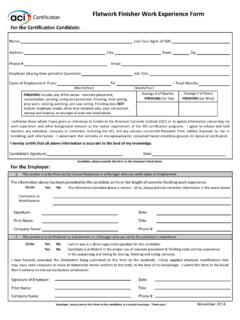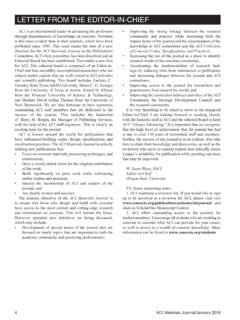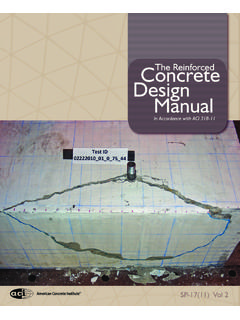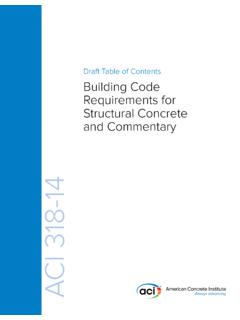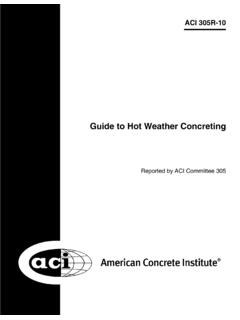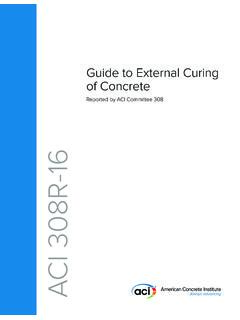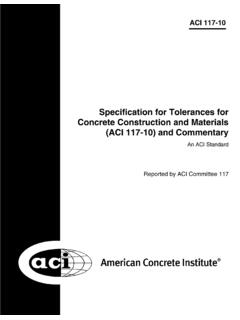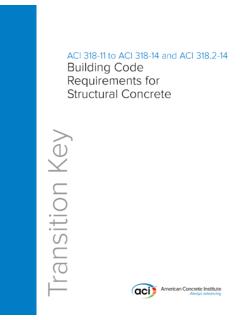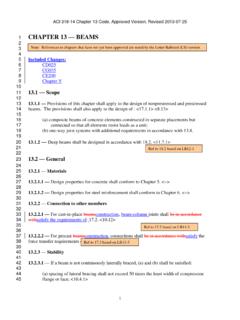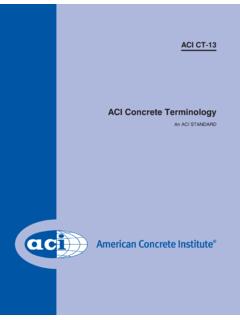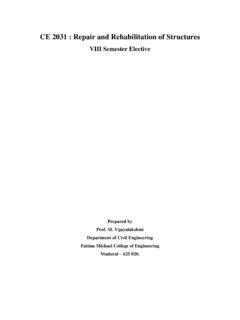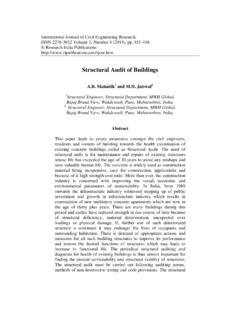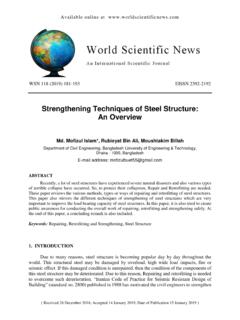Transcription of 437R-19: Strength Evaluation of Existing Concrete Buildings
1 Strength Evaluation of Existing Concrete BuildingsReported by ACI Committee 437 ACI 437R-19 First PrintingMay 2019 ISBN: 978-1-64195-059-6 Strength Evaluation of Existing Concrete BuildingsCopyright by the American Concrete Institute, Farmington Hills, MI. All rights reserved. This material may not be reproduced or copied, in whole or part, in any printed, mechanical, electronic, film, or other distribution and storage media, without the written consent of technical committees responsible for ACI committee reports and standards strive to avoid ambiguities, omissions, and errors in these documents. In spite of these efforts, the users of ACI documents occasionally find information or requirements that may be subject to more than one interpretation or may be incomplete or incorrect.
2 Users who have suggestions for the improvement of ACI documents are requested to contact ACI via the errata website at Proper use of this document includes periodically checking for errata for the most up-to-date committee documents are intended for the use of individuals who are competent to evaluate the significance and limitations of its content and recommendations and who will accept responsibility for the application of the material it contains. Individuals who use this publication in any way assume all risk and accept total responsibility for the application and use of this information in this publication is provided as is without warranty of any kind, either express or implied, including but not limited to, the implied warranties of merchantability, fitness for a particular purpose or and its members disclaim liability for damages of any kind, including any special, indirect, incidental, or consequential damages, including without limitation, lost revenues or lost profits.
3 Which may result from the use of this is the responsibility of the user of this document to establish health and safety practices appropriate to the specific circumstances involved with its use. ACI does not make any representations with regard to health and safety issues and the use of this document. The user must determine the applicability of all regulatory limitations before applying the document and must comply with all applicable laws and regulations, including but not limited to, United States Occupational Safety and Health Administration (OSHA) health and safety by governmental representatives in the work of the American Concrete Institute and in the development of Institute standards does not constitute governmental endorsement of ACI or the standards that it information.
4 ACI documents are available in print, by download, through electronic subscription, or reprint and may be obtained by contacting ACI standards and committee reports are gathered together in the annually revised the ACI Collection of Concrete Codes, Specifications, and Concrete Institute38800 Country Club DriveFarmington Hills, MI 48331 Phone: + : + Strength of Existing Concrete Buildings and structures can be evaluated analytically and supplemented where necessary with load testing. The recommendations in this report indicate when such an Evaluation may be needed, establish criteria for selecting the Evaluation method, and indicate the data and background infor-mation necessary for an Evaluation .
5 Methods of determining mate-rial properties used in the analytical and load test investigations are described in detail. Analytical investigations should follow the principles of Strength design. Working stress analysis can supple-ment the analytical investigations by relating the actual state of stress in structural components to the observed : cracking; deflection; deformation; deterioration; gravity load; load; load test; reinforced Concrete ; Strength ; Strength Evaluation ; 1 INTRODUCTION AND SCOPE, p. Introduction, p. Scope, p. 2 CHAPTER 2 DEFINITIONS, p. 3 CHAPTER 3 PRELIMINARY INVESTIGATION, p. Review of Existing information, p.
6 Condition survey of structure , p. 4 CHAPTER 4 METHODS FOR MATERIAL Evaluation , p. Concrete , p. Reinforcing steel, p. Fiber-reinforced polymer reinforcement systems, p. 16 CHAPTER 5 assessment OF LOADING CONDITIONS AND SELECTION OF Evaluation METHOD, p. assessment of loading and environmental condi-tions, p. Selecting the proper method of Evaluation , p. 18 CHAPTER 6 Evaluation AND INTERPRETATION OF RESULTS, p. Analytical Evaluation , p. Supplementing the analytical Evaluation with load tests, p. 20 CHAPTER 7 REFERENCES, p. 24 Authored documents, p. 25 Paul H. Ziehl*, ChairAaron K. Larosche*, SecretaryACI 437R-19 Strength Evaluation of Existing Concrete BuildingsReported by ACI Committee 437 Nicholas J.
7 Carino*Paolo CasadeiJohn A. Frauenhoffer*Nestore Galati*Zareh B. GregorianPawan R. GuptaFrederick D. Heidbrink*Jason S. Johnson*Ashok M. KakadeDanielle D. KleinhansAndrew T. KrauklisCarl J. Larosche*Daniel J. McCarthy*Antonio Nanni*Thomas E. NehilK. Nam ShiuJ. Gustavo Tumialan*Jeffrey S. WestConsulting MembersMarco ArduiniGrant T. HalvorsenHabib M. Zeim Alabideen*Members of the committee who prepared this Committee Reports, Guides, and Commentaries are intended for guidance in planning, designing, executing, and inspecting construction. This document is intended for the use of individuals who are competent to evaluate the significance and limitations of its content and recommendations and who will accept responsibility for the application of the material it contains.
8 The American Concrete Institute disclaims any and all responsibility for the stated principles. The Institute shall not be liable for any loss or damage arising to this document shall not be made in contract documents. If items found in this document are desired by the Architect/Engineer to be a part of the contract documents, they shall be restated in mandatory language for incorporation by the 437R-19 supersedes 437R-03 and was adopted and published May 2019, American Concrete rights reserved including rights of reproduction and use in any form or by any means, including the making of copies by any photo process, or by electronic or mechanical device, printed, written, or oral, or recording for sound or visual reproduction or for use in any knowledge or retrieval system or device.
9 Unless permission in writing is obtained from the copyright 1 INTRODUCTION AND IntroductionThis report defines the process of structural Evaluation to determine the structural adequacy of Existing Concrete struc-tures as defined by ACI 562. The procedures can be applied generally to new Concrete structures, provided that appro-priate Evaluation criteria are agreed upon before the start of the investigation. This report covers structural Concrete , including conventionally reinforced cast-in-place Concrete , precast-prestressed Concrete , precast post-tensioned Concrete , and post-tensioned cast-in-place Background and limitations Engineering judgment based on rational, scientific principles is critical in the Strength Evaluation of Concrete structures.
10 Such judgment of a quali-fied licensed design professional is needed for proper applica-tion of relevant code provisions to the case being studied. An assessment of structural safety can be achieved with the infor-mation and data from field investigations, scientific computa-tions based on sound principles, as well as subjective engi-neering judgment from the licensed design professional. This is particularly true for structures deteriorated from prolonged exposure to the environment or damaged in an extreme event, such as a fire , earthquake, or , there are no generally recognized criteria for evaluating serviceability of an Existing Concrete structure . Such Evaluation requires engineering judgment based on scientific principles, and close consultation with the owner regarding the intended use of the structure and expected level of 562 discusses potential conclusions resulting from a Strength Evaluation .
